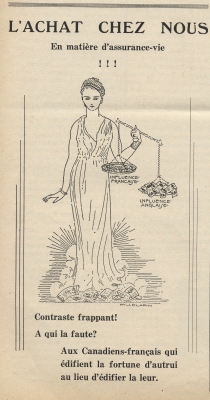On the threshold of its 150th year of existence, the Union du Canada Assurance-Vie located at George and Dalhousie streets, declares bankruptcy against a backdrop of multiple allegations: abuse of power, intimidation and conflict of interest on the part of its former president. This controversial end casts a shadow over the past of this mutual society, which for a long time was an extremely important link in the French-Canadian institutional network.
The Union Saint-Joseph is founded in Ottawa in 1863 by two shoemakers from Joliette. It emerges in the context of the effervescence of mutualist and cooperative movements in North America, which seek to counteract the deleterious effects of the industrial revolution and massive urbanization on the working class. Inspired by the contingency methods of Quebec mutual associations, the Union offers its members social security in case of illness or death, meaning they need not rely on public assistance, a solution negatively perceived in most circles. In its early days, membership includes mainly representatives of Ottawa’s young working class composed of blacksmiths, cabinetmakers, painters, butchers, masons and stonecutters.
Many mutual associations disappear after the collapse of this associative model at the turn of the 20th century. But Ottawa’s Union Saint-Joseph, which becomes the Union Saint-Joseph of Canada in 1905, on the contrary, demonstrates surprising longevity. According to historian Pierrick Labbé, “it was the socio-political situation of Ottawa’s French Canadians which influenced its destiny when it tried to avoid bankruptcy.”1 Without neglecting its original social and benevolent purpose at the local level, the Union Saint-Joseph broadens its mission by taking on a national vocation oriented toward helping French-Canadian culture survive. Membership in the Union Saint-Joseph includes an oath of fidelity to the Catholic faith and French language, and a commitment to their defence on Canadian soil.
By combining contingency with the flourishing French-Canadian national project, the Union maintains its head office in Ottawa, and develops an extensive branch network throughout French Canada and even in the United States. It also takes part in various struggles to defend the rights and interests of Francophones. As a result, the Union finds itself involved in the movement which gives birth to the Association canadienne-française d’éducation d’Ontario (ACFÉO) in 1910, and in the battle against Regulation 17, which the Union criticizes, particularly in the pages of its newspaper Le Prévoyant.
In 1959, the Union Saint-Joseph becomes the Union du Canada, a national life insurance company similar to most major companies in this sector of economic activity. Shortly before its legal liquidation, the Union managed approximately 22,000 insurance policies across Canada, with a clientele concentrated mainly in Quebec.
1 Pierrick Labbé, “L’Union fait la force !”: L’Union Saint-Joseph d’Ottawa/du Canada 1863-1920, Ottawa, University of Ottawa Press, 2012, p. 166 (translated from the original).
Personnel at the Union Saint-Joseph du Canada head office, Ottawa, Ottawa [ca. 1950].
Source: University of Ottawa, CRCCF, Fonds Union du Canada (C20), Ph20-58.






